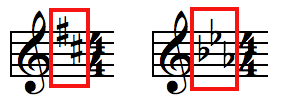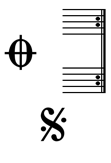When reading piano music a musician must know more then just the notes on the staff. There are many other factors involved that need to be addressed when reading piano notes.
There is so much information on a piece of music that it is important that the musician scans the entire piece and takes note of each detail before attempting to play the song.
There are so many small details in a piece of music, that if not prepared, will pass you by.
Remember, every song has a steady rhythm that it follows, it’s not going to stop to let you catch up from a missed cue in the music.
The best tip on sight reading music I can give you is to
Know What’s Going To Happen Before It Happens!
Take a look over the piece of music before you start to play it and take notes. Look for these important parts of a piece of sheet music listed below so you will be ready for them when they show up.
Recognize Key
The very first thing you need to take note of when sight reading music is the key signature. The key signature is used to show how many sharps and flats are in a particular piece of music.
The key signature is located at the beginning of each line of music on both the treble clef and bass clef.
At the beginning of both clefs there will be a varying number of sharps or flats. The number of sharps and flats will tell you which key the song being played is in.

Use this key signature chart as a guide for learning key signatures fast!
Tempo
The tempo of the song is how fast or slow the song should be played.
Tempo is usually shown in Beats Per Minute or bpm. The higher the number of of beats per minute the faster the song, the lower number the slower the song,
At the beginning of each piece of music, look for a numeric number representing the bpm. You can put this number into your metronome when reading piano music to make sure that you are in perfect time.
Dynamics
Always take the time to scan for dynamics when reading piano music.
Throughout a piece of music the volume in which you play can change dramatically.
Without dynamics, a song would be lifeless. There would be no emphasis, no character.
Start by looking at the beginning of the piece for dynamic symbols. Some songs start out soft and raise in volume as the piece goes on. Others start loud then get soft.
There are constant changes in dynamics that you need to check for in order to really nail the performance. Check for crescendo’s and decrescendo’s and other music note symbols such as forte, piano, and pianissimo.
Make sure you mark when and where there are volume changes when sight reading music.
Repeats

In order to consolidate space, most pieces of music use repeat sings to show when a passage, or part of a song repeats itself.
There are a lot of different types of repeat sings that you need to be away of when reading piano music. Check out this page to learn more about repeat sings.
Go through the piece of music and make sure you know the layout of the song. The repeats are used as a roadmap to guide you through each section of the song. Don’t get lost when the sheet music asks you to start back over at the beginning.
Make sure you know exactly where to go so that you won’t get mixed up while playing the song.
Key Changes
Key changes can happen anywhere in a song. Say you are playing a song in C, and then all of a sudden it wants you to play in Db, you need to be aware of all instances of key changes in a song.
A key change happens when there are sharp or flat symbols in the middle of the music.
Remember when I said that the key signature of a song is always at the beginning of each line?
To show that there is a key change, the music will have these symbols sitting in the middle of the music letting you know that it’s time to switch keys.
Scan through the piece before you start to play. Mark the key changes, if any, so you are ready to make adjustments in the sharps and flats in a song.
Preview the Piece
Reading piano notes can be a little difficult. To make sure that you are going to play a song the best that you can, make sure to scan the music before you start playing.
Being able to sight read a song without every looking at it is a skill that takes quite some time to master, but if you are still a beginner at reading piano music then need to make sure to scan, scan, scan!
Take your pencil and write all over the sheet music. Take as many notes as you can so that when you are practicing and performing the piece, that you are ready for any sudden changes that take place.
There is a lot that can happen in a piece of sheet music, study the piece so you won’t miss a thing.
Go From Reading Piano Music Back to Lessons
Back to Home Page

